The Ultimate Guide to Passport Bags: Travel Smart and Secure
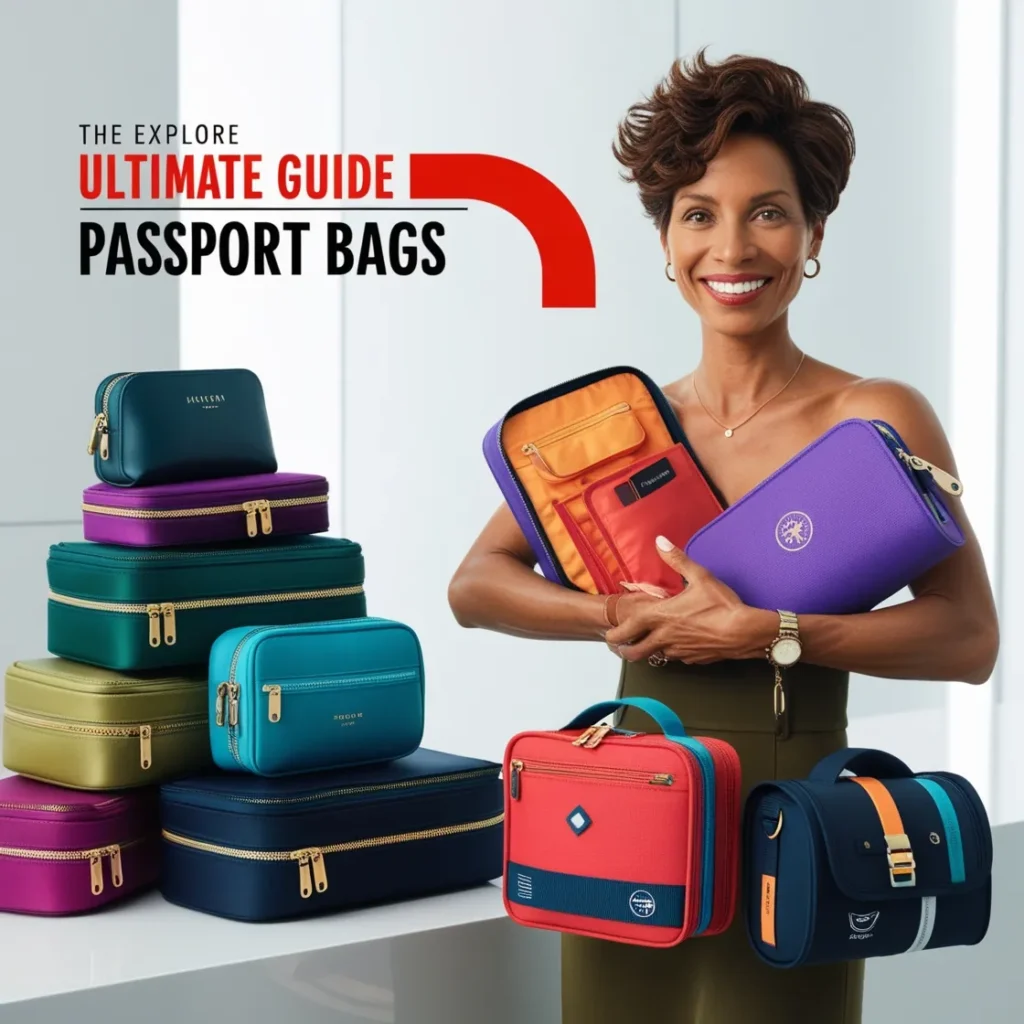
Introduction
Picture this: You’re rushing through a bustling airport, juggling your carry-on luggage and a cup of coffee. Suddenly, panic sets in as you realize you can’t find your passport. Sound familiar? If you’ve ever experienced this heart-stopping moment or want to avoid it, you’re in the right place. Welcome to the ultimate guide on passport bags—your ticket to stress-free, secure travel.
In today’s world of increasing travel complexities and security concerns, protecting your passport isn’t just a good idea—it’s essential. Enter the passport bag—a simple yet ingenious solution to keep your most important travel document safe and accessible.
In this comprehensive guide, we’ll explore everything you need about passport bags. From understanding their purpose to choosing the perfect one for your travel style, we’ve got you covered. By the end of this article, you’ll be equipped with the knowledge to travel smarter, more securely, and with greater peace of mind.
So, fasten your seatbelts and get ready for a journey through the world of passport bags. Whether you’re a seasoned globetrotter or planning your first international adventure, this guide will ensure your passport stays safe, allowing you to focus on what matters—enjoying your travels.
Also Check Drawing Ideas: 101+ Exciting Drawing Ideas to Inspire Your Next Masterpiece

What is a passport bag?
Before we dive into the nitty-gritty, let’s start with the basics: What exactly is a passport bag?
A passport bag, also known as a passport holder or travel wallet, is a specialized accessory designed to securely store and protect your passport and other essential travel documents. But it’s more than just a fancy envelope for your passport. These bags are engineered with features to enhance security, organization, and convenience while you’re on the move.
A Brief History
The concept of passport bags has evolved alongside the history of modern travel. As international travel became more accessible in the 20th century, travelers needed better ways to keep their documents safe. The first passport holders were simple leather sleeves, designed to protect the passport from wear and tear.
As travel became more complex and security concerns grew, especially in the digital age, passport bags evolved. They incorporated features like RFID blocking technology, water-resistant materials, and multiple compartments for various travel essentials.
How Passport Bags Differ from Regular Wallets or Travel Organizers
While you might be tempted to use your everyday wallet or a general travel organizer for your passport, passport bags offer distinct advantages:
- Specialized Size: Passport bags are specifically designed to fit passports snugly, preventing them from slipping out or getting bent.
- Enhanced Security Features: Many passport bags come with anti-theft features like RFID blocking and hidden compartments.
- Travel-Centric Design: They often include space for boarding passes, multiple currencies, and other travel-specific items.
- Durability: Passport bags are built to withstand the rigors of travel, often featuring water-resistant and tear-resistant materials.
- Wearability: Unlike regular wallets, many passport bags can be worn around the neck or waist for added security and convenience.
Understanding these key differences highlights why a dedicated passport bag is a worthwhile investment for any traveler. In the next section, we’ll explore why you might need one for your adventures.
Why You Need a Passport Bag for Travel
Now that we’ve defined what a passport bag is, let’s talk about why you should consider using one. The benefits go far beyond simply carrying your passport.
1. Enhanced Security
In an era where identity theft and digital pickpocketing are real concerns, passport bags offer a crucial layer of protection:
- Physical Security: Many passport bags are designed to be worn close to your body, under clothing, making it difficult for pickpockets to access.
- RFID Blocking: Modern passports and credit cards contain RFID chips that can be scanned remotely. Many passport bags include RFID-blocking materials to prevent electronic theft.
- Water and Tear Resistance: Quality passport bags protect your documents from environmental damage, ensuring they remain legible and valid.
2. Organization and Convenience
Fumbling through your bag at security checkpoints or immigration counters can be stressful. Passport bags help you stay organized:
- Everything in One Place: Keep your passport, boarding passes, currency, and other essential documents together.
- Easy Access: Designed for quick retrieval of your travel documents when you need them most.
- Multiple Compartments: Segregate different items for easy organization and access.
3. Peace of Mind
Perhaps the most valuable benefit of a passport bag is the peace of mind it provides:
- Reduced Stress: Knowing exactly where your essential documents are at all times.
- Confidence in Security: Trust that your sensitive information is protected from both physical and electronic theft.
- Focus on Enjoyment: With your documents secure, you can focus on enjoying your travel experience.
4. Protection Against Loss and Damage
Losing your passport or having it damaged can derail your entire trip:
- Prevent Accidental Loss: A dedicated bag reduces the risk of your passport slipping out unnoticed.
- Protection from Elements: Many passport bags offer protection against rain, spills, and other potential sources of damage.
- Durability: Quality passport bags are built to last, protecting your documents through multiple trips.
5. Travel Insurance Compliance
Some travel insurance policies require you to keep your passport secure. Using a passport bag can help ensure you’re meeting these requirements, potentially saving you headaches if you need to make a claim.
By investing in a good passport bag, you’re not just buying a product – you’re investing in a smoother, more secure travel experience. In the next section, we’ll explore the different types of passport bags available, helping you find the perfect fit for your travel style.
Also, Check The Ultimate Guide to Christmas Clipart: Spreading Holiday Cheer Through Digital Art

Types of Passport Bags
Passport bags come in various styles, each designed to cater to different travel needs and preferences. Let’s explore the most common types:
1. Neck Wallets
Description: These are slim, pouch-like bags worn around the neck and tucked under clothing.
Pros:
- Extremely secure when worn under clothes
- Hands-free
- Difficult for pickpockets to access
Cons:
- Can be uncomfortable in hot weather
- Limited capacity
Best for: Budget travelers, backpackers, and those prioritizing security over quick access.
2. Belt Bags
Description: Also known as money belts, these thin pouches are worn around the waist, often concealed under clothing.
Pros:
- Very discreet
- Comfortable for long periods
- Good capacity for essential items
Cons:
- Can be awkward to access in public
- May be uncomfortable when sitting for long periods
Best for: Adventure travelers, hikers, and those visiting areas with high pickpocket risks.
3. Crossbody Passport Bags
Description: These are small bags worn across the body, offering a blend of security and accessibility.
Pros:
- Easy to access
- Can be worn over or under clothing
- Often have multiple compartments
Cons:
- More visible than neck wallets or belt bags
- Can be bulky depending on the design
Best for: City travelers, families, and those needing frequent document access.
4. RFID-Blocking Wallets
Description: These are wallet-style holders specifically designed to block RFID signals.
Pros:
- Protect against electronic pickpocketing
- Often sleek and stylish
- Easy to slip into a pocket or bag
Cons:
- Limited capacity
- No wearable option for added security
Best for: Tech-savvy travelers, business travelers, and those primarily concerned with digital security.
5. Multi-Purpose Travel Organizers
Description: Larger organizers that can hold passports, tickets, multiple currencies, and even small electronics.
Pros:
- High capacity
- Great for family travel
- Keep all travel documents organized
Cons:
- Bulkier than other options
- May be too large to wear comfortably
Best for: Family travelers, long-term travelers, and those who prefer to keep all documents together.
Choosing the Right Type for You
When selecting a passport bag, consider:
- Your travel style (backpacking, luxury, business, family)
- The destinations you’ll be visiting (consider security risks)
- How often you’ll need to access your documents
- Climate and weather conditions
- Personal comfort preferences
Remember, there’s no one-size-fits-all solution. Some travelers even use a combination of passport bags for different situations. In the next section, we’ll dive into the key features to look for in a passport bag, helping you make an informed decision.
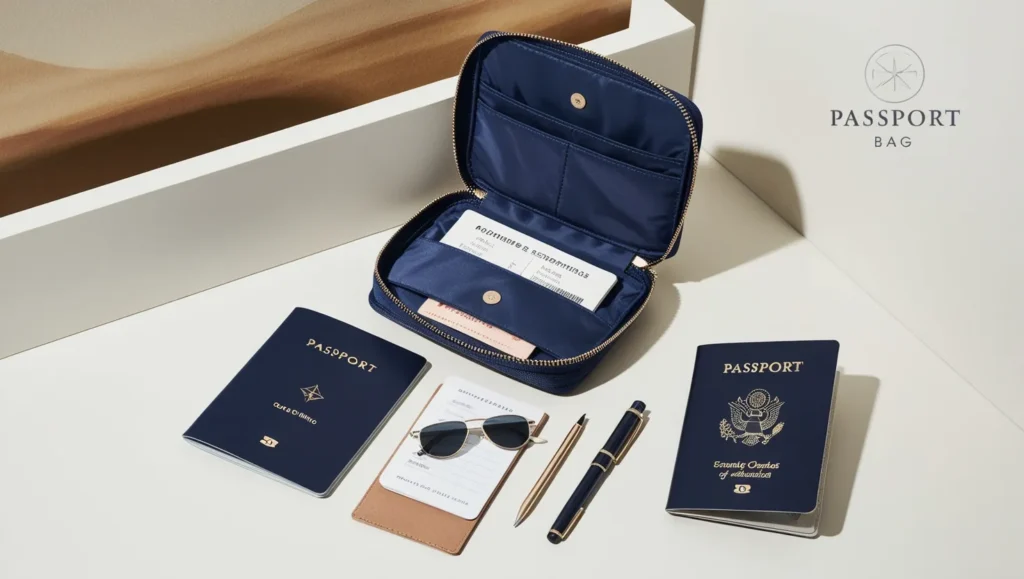
Key Features to Look for in a Passport Bag
Now that you’re familiar with the different types of passport bags, let’s explore the essential features that make a passport bag truly effective. When shopping for your ideal travel companion, keep an eye out for these key attributes:
1. RFID Blocking Technology
In today’s digital age, electronic pickpocketing is a real concern. RFID (Radio-Frequency Identification) blocking technology prevents unauthorized scanning of your passport and credit cards.
What to look for:
- Materials like carbon fiber, aluminum, or specific RFID-blocking fabrics
- Certification or testing information for RFID blocking effectiveness
Why it matters: Protects your personal and financial information from digital theft.
2. Water-Resistant Materials
Unexpected rain showers, spills, or high humidity can damage your important documents. Water-resistant materials provide an extra layer of protection.
What to look for:
- Fabrics like nylon, polyester, or treated leather
- Water-resistant zippers
- Waterproof ratings (if available)
Why it matters: Keeps your documents dry and legible in various weather conditions.
3. Durability and Build Quality
A passport bag should withstand the rigors of travel and protect your documents effectively.
What to look for:
- Strong stitching and reinforced stress points
- High-quality zippers (YKK is a reliable brand)
- Tear-resistant fabrics
Why it matters: Ensures your bag lasts through multiple trips and continues to protect your documents.
4. Size and Capacity
The ideal size depends on your travel style and what you need to carry.
What to look for:
- Snug fit for your passport
- Additional pockets for cards, cash, and other small items
- Ability to hold boarding passes without folding
Why it matters: Balances protection and organization with convenience and comfort.
5. Comfort and Wearability
If you’re opting for a wearable passport bag, comfort is crucial, especially for long travel days.
What to look for:
- Adjustable straps
- Breathable materials for neck wallets or belt bags
- Slim profile for discreet wear under clothing
Why it matters: Ensures you’ll use the bag consistently throughout your trip.
6. Additional Storage Compartments
Organized travelers appreciate thoughtful compartmentalization.
What to look for:
- Dedicated slots for cards and IDs
- Zippered pockets for coins or keys
- Clear window for easy ID checks
Why it matters: Keeps all your travel essentials organized and easily accessible.
7. Security Features
Beyond RFID blocking, look for features that enhance physical security.
What to look for:
- Hidden pockets
- Slash-resistant materials or straps
- Locking zippers
Why it matters: Provides peace of mind in crowded or unfamiliar environments.
8. Ease of Use
A passport bag should make your travel easier, not more complicated.
What to look for:
- Easy-to-use closures (avoiding complicated locks)
- Quick-access pockets for frequently used items
- Intuitive organization
Why it matters: Reduces stress and saves time during security checks and immigration.
9. Style and Discretion
While functionality is key, you might also want a bag that fits your personal style.
What to look for:
- Neutral colors for discretion
- Design that can be worn over or under clothing
- Professional look for business travelers
Why it matters: Ensures you feel comfortable and confident using the bag in various settings.
By prioritizing these features based on your personal needs and travel style, you’ll be well-equipped to choose a passport bag that enhances your travel experience. In the next section, we’ll review some top passport bags on the market to help narrow down your choices.
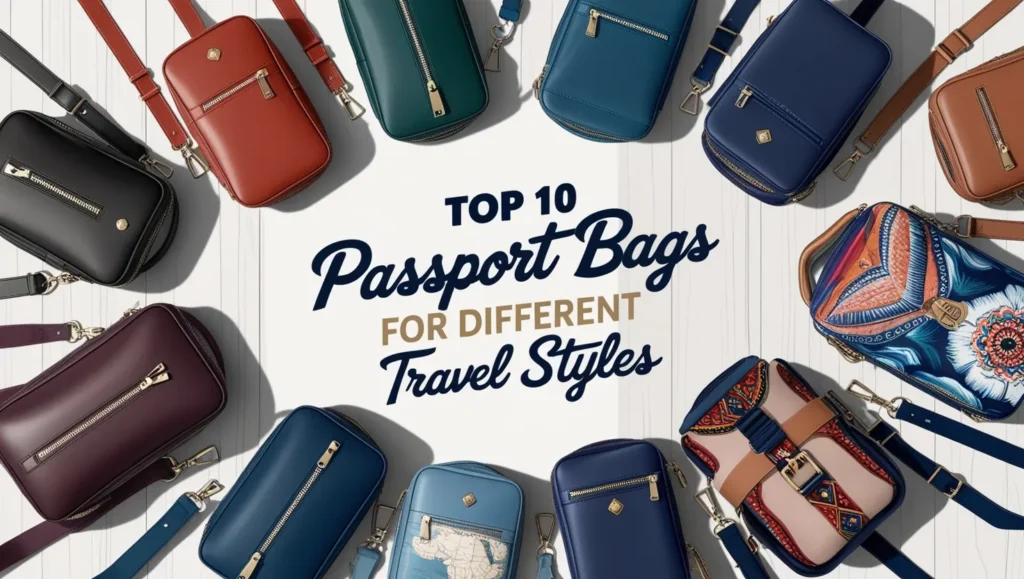
Top 10 Passport Bags for Different Travel Styles
Now that we’ve covered the key features to look for, let’s explore some of the best passport bags available on the market. We’ve categorized them based on different travel needs and styles to help you find the perfect match.
1. Best Overall Passport Bag
Product: TravelMate Pro Crossbody RFID Passport Holder
Key Features:
- RFID blocking technology
- Water-resistant nylon material
- Multiple compartments for optimal organization
- Adjustable crossbody strap
- Sleek, unisex design
Why We Love It: This bag strikes the perfect balance between security, functionality, and style. It’s suitable for various travel scenarios and offers easy access to your documents.
2. Best Budget-Friendly Option
Product: SafeTravel Basic Neck Wallet
Key Features:
- Affordable price point
- RFID blocking
- Lightweight and comfortable for all-day wear
- Two zippered compartments
Why We Love It: It offers essential security features at a wallet-friendly price, making it perfect for budget-conscious travelers or those new to using passport bags.
3. Most Secure Passport Bag
Product: FortressGuard Ultimate Security Belt
Key Features:
- Slash-resistant material
- Hidden zippered compartments
- RFID blocking
- Waterproof construction
- Comfortable, breathable back panel
Why We Love It: For travelers visiting high-risk areas or those extremely concerned about security, this belt offers top-notch protection without sacrificing comfort.
4. Best for Family Travel
Product: FamilyJourney Travel Organizer
Key Features:
- Large capacity to hold multiple passports
- Dedicated sections for different currencies
- Removable wrist strap
- RFID protection
- Durable, wipeable exterior
Why We Love It: This organizer keeps the whole family’s travel documents in one secure place, making it easier to manage group travel.
5. Most Stylish Passport Bag
Product: UrbanExplorer Leather Passport Wallet
Key Features:
- Premium leather construction
- RFID blocking lining
- Sleek, minimalist design
- Multiple card slots and a pen holder
- Available in various colors
Why We Love It: For the fashion-conscious traveler, this wallet offers security without compromising on style. It’s perfect for business trips or luxury travel.
6. Best for Adventure Travel
Product: OutdoorPro Adventure Neck Wallet
Key Features:
- Highly water-resistant material
- Reinforced stitching for durability
- Breathable back panel to prevent sweating
- Multiple zippered compartments
- Adjustable, break-away neck strap for safety
Why We Love It: Designed to withstand tough conditions, this neck wallet is ideal for hikers, campers, and adventure seekers.
7. Most Versatile Passport Bag
Product: FlexiTravel 3-in-1 Passport Holder
Key Features:
- Can be worn as a neck wallet, crossbody bag, or belt bag
- RFID blocking
- Water-resistant material
- Clear smartphone-compatible window
- Detachable straps
Why We Love It: This adaptable bag suits various travel styles and situations, offering flexibility for different parts of your journey.
8. Best for Business Travelers
Product: ExecuTravel RFID Passport Wallet
Key Features:
- Professional leather exterior
- Dedicated boarding pass compartment
- Multiple currency pockets
- RFID protection
- Pen holder and business card slots
Why We Love It: Designed with the business traveler in mind, this wallet keeps you organized and looking professional.
9. Most Comfortable to Wear
Product: ComfortFit Undercover Money Belt
Key Features:
- Ultra-thin profile for discreet wear
- Moisture-wicking back panel
- Soft, stretchy waistband
- RFID blocking
- Two zippered compartments
Why We Love It: This money belt prioritizes comfort, making it ideal for long travel days or warm climates.
10. Best Eco-Friendly Passport Bag
Product: GreenJourney Recycled Passport Holder
Key Features:
- Made from 100% recycled materials
- RFID blocking technology
- Water-resistant coating
- Multiple compartments for organization
- Biodegradable packaging
Why We Love It: This passport holder proves that security and sustainability can go hand in hand. It’s perfect for eco-conscious travelers looking to reduce their environmental impact without compromising on functionality.
How to Choose the Right Passport Bag for Your Needs
With so many options available, selecting the perfect passport bag can feel overwhelming. Here’s a step-by-step guide to help you make the right choice:
1. Assess Your Travel Style
Consider the types of trips you typically take:
- Are you a backpacker, luxury traveler, or business professional?
- Do you prefer urban exploration or outdoor adventures?
- How frequently do you travel?
Your travel style will influence the type of bag that suits you best. For instance, a sleek wallet might be perfect for business trips, while a durable neck wallet could be ideal for backpacking.
2. Consider Your Destination
Different locations come with different security concerns:
- Are you visiting areas known for pickpocketing?
- Will you be in humid or rainy climates?
- Are you traveling to multiple countries with different currencies?
For high-risk areas, prioritize security features. For diverse climates, focus on durability and water resistance.
3. Evaluate Accessibility Needs
Think about how often you’ll need to access your documents:
- Will you be going through multiple security checkpoints?
- Are you taking many short flights or train rides?
- Do you prefer to keep your passport concealed or easily accessible?
Frequent document checks might necessitate a more accessible design, while long stretches of travel could prioritize concealment.
4. Balance Security with Convenience
While security is crucial, it shouldn’t come at the cost of usability:
- Are you comfortable with under-clothing storage?
- Do you need quick access to other items like a phone or cash?
- How important is RFID protection for your travel plans?
Find a balance that makes you feel secure without causing constant inconvenience.
5. Match the Bag to Your Personal Style
Your passport bag doesn’t have to be purely functional:
- Do you prefer a minimalist look or something more eye-catching?
- Is blending in with locals important to you?
- For business travelers: does the bag look professional?
Choose a bag that you’ll be happy to use and that fits with your overall travel aesthetic.
6. Consider Additional Storage Needs
Think about what else you might want to carry:
- Do you need space for multiple passports (family travel)?
- Will you be carrying different currencies?
- Do you want room for a small notebook or pen?
Ensure the bag has enough compartments to meet your organizational needs without becoming bulky.
7. Set a Budget
Passport bags come at various price points:
- Determine how much you’re willing to invest.
- Consider the bag’s durability and how often you’ll use it.
- Remember that a good passport bag is an investment in your travel security.
While it’s possible to find budget-friendly options, investing in a high-quality bag can pay off in longevity and peace of mind.
8. Read Reviews and Recommendations
Before making a final decision:
- Read user reviews to learn about real-world performance.
- Ask fellow travelers for recommendations.
- Check travel forums for discussions about passport bag experiences.
Real user experiences can provide insights that product descriptions might miss.
By carefully considering these factors, you’ll be well-equipped to choose a passport bag that not only meets your practical needs but also enhances your overall travel experience. Remember, the best passport bag is one that you’ll consistently use and feel comfortable with throughout your journey.
Tips for Using Your Passport Bag Effectively
Once you’ve chosen the perfect passport bag, it’s important to use it correctly to maximize its benefits. Here are some expert tips to help you make the most of your new travel companion:
1. Proper Organization Techniques
- Develop a System: Assign specific pockets for different items (e.g., passport always goes in the innermost pocket).
- Use Plastic Sleeves: For important documents, consider using clear, waterproof sleeves for extra protection.
- Separate Currencies: If traveling to multiple countries, use different compartments for each currency.
- Keep a Checklist: Create a small checklist of contents and tape it inside your bag for quick reference.
2. How to Wear Your Passport Bag Discreetly
- Under Clothing: For neck wallets and money belts, wear them under your outer layer of clothing.
- Adjust for Comfort: Ensure straps are properly adjusted to prevent chafing or discomfort.
- Layer Strategically: In cold climates, wear the bag over your base layer but under your jacket.
- Practice Access: Before your trip, practice accessing your bag discreetly to avoid fumbling in public.
3. Balancing Accessibility and Security
- Plan Ahead: Before reaching security checkpoints, move necessary documents to an easily accessible pocket.
- Use Hotel Safes: When you don’t need your passport, store it in the hotel safe and only carry essential items in your passport bag.
- Be Situationally Aware: In crowded or high-risk areas, keep your bag concealed. In safer environments, you can prioritize accessibility.
- Rotate Valuable Items: Periodically change the location of valuable items within your bag to increase security.
4. Maintenance and Cleaning Tips
- Regular Cleaning: Wipe down your passport bag with a damp cloth regularly, especially after long trips.
- Deep Clean: For fabric bags, hand wash with mild soap and air dry completely before use.
- Check for Wear: Regularly inspect seams, zippers, and straps for signs of wear and repair or replace as needed.
- Waterproofing: For non-waterproof bags, consider applying a waterproofing spray for added protection.
5. Digital Backup Strategy
- Scan Important Documents: Create digital copies of your passport, ID, and other crucial documents.
- Secure Cloud Storage: Store these scans in a secure cloud service for easy access if physical documents are lost.
- Emergency Contact Info: Keep a physical copy of emergency contacts in your passport bag.
6. Customization for Comfort
- Add Padding: For neck wallets, consider adding a soft fabric cover to prevent chafing.
- Use Carabiners: Attach small carabiners to your bag for keys or water bottles, freeing up internal space.
- Create Divisions: Use small pouches within larger compartments to further organize items.
7. Security Best Practices
- Be Consistent: Always return items to the same spot in your bag to quickly notice if anything is missing.
- Use in Conjunction with Other Methods: Combine your passport bag with other security measures like luggage locks.
- Keep it Close: When sleeping in public areas (like airports), keep your passport bag close to your body or looped through a sturdy strap on your main luggage.
8. Educate Travel Companions
- Share Your System: If traveling with others, explain your organization system so they can assist if needed.
- Designate Responsibilities: In group travel, consider assigning different documents or items to different people’s passport bags.
By following these tips, you’ll not only keep your documents secure but also streamline your travel experience. Remember, the key to effectively using a passport bag is consistency and awareness. With practice, using your passport bag will become second nature, allowing you to focus on enjoying your travels with peace of mind.
Beyond Passports: What Else to Keep in Your Passport Bag
While the primary purpose of a passport bag is to protect your passport, it can serve as a secure hub for various essential travel items. Here’s a comprehensive list of what you might consider keeping in your passport bag, along with the reasons why:
1. Essential Travel Documents
- Passport: The primary item, of course.
- Visa Documentation: Any necessary visa paperwork or permits.
- Travel Insurance Information: Policy details and emergency contact numbers.
- Vaccination Records: Especially important in the post-COVID era.
- Driver’s License or International Driving Permit: For identification and car rentals.
Why: Keeping all official travel documents together ensures you’re prepared for any official checks or emergencies.
2. Financial Items
- Credit and Debit Cards: Bring cards from different networks for backup.
- Cash: Small amounts of local currency and some US dollars (widely accepted).
- Travel Money Cards: Prepaid cards specifically for travel.
- Emergency Checks: Traveler’s checks, if you still use them.
Why: Diversifying your payment methods provides security and flexibility.
3. Identification and Personal Information
- Copy of Passport: A paper copy of your passport’s main page.
- Secondary Form of ID: Such as a student ID or work ID.
- Emergency Contact Card: With numbers for family, embassy, and insurance provider.
- Medical Information Card: Listing blood type, allergies, and any chronic conditions.
Why: These backups can be crucial in emergencies or if your main documents are lost.
4. Travel Itinerary Items
- Boarding Passes: For upcoming flights or train journeys.
- Hotel Reservations: Printouts or confirmation numbers.
- Tour Vouchers: For any pre-booked activities or excursions.
- Transportation Tickets: Such as bus or ferry tickets.
Why: Having these on hand streamlines your travel process and serves as proof of bookings.
5. Digital Essentials
- Portable Charger: A slim power bank for emergency phone charging.
- Extra SIM Card: If you’re using local SIMs in different countries.
- USB Drive: With scanned copies of important documents.
Why: These items ensure you stay connected and have access to digital copies of crucial information.
6. Miscellaneous Useful Items
- Pen: For filling out immigration forms or making quick notes.
- Small Notebook: For jotting down addresses, directions, or travel tips.
- Spare Passport Photos: Useful for visa applications on arrival.
- Medication: A day’s worth of any essential medication.
- Glasses Prescription: If you wear corrective lenses.
Why: These items can save time and stress in various travel scenarios.
7. Comfort Items
- Earplugs and Eye Mask: For comfortable rest during long journeys.
- Hand Sanitizer: A travel-sized bottle for hygiene on the go.
- Tissues or Wet Wipes: For quick clean-ups.
Why: These small items can significantly improve comfort during travel.
Tips for Packing Your Passport Bag
- Prioritize Essentials: Not everything on this list needs to be in your passport bag. Prioritize based on your specific trip and needs.
- Avoid Overpacking: Keep your passport bag slim and light. Overstuffing can make it bulky and uncomfortable to wear.
- Use Clear Pouches: Organize items into clear, ziplock pouches for easy visibility and extra protection against moisture.
- Rotate Items: Regularly review and update the contents of your passport bag based on your current travel plans.
- Know Your Limits: Be aware of currency declaration limits when crossing borders and adjust the cash you carry accordingly.
- Digital Backups: For any paper item you carry, have a digital backup stored securely in the cloud.
Remember, the goal is to strike a balance between being prepared and keeping your passport bag manageable. By thoughtfully selecting what to include, you’ll create a travel toolkit that provides security, convenience, and peace of mind throughout your journey.
Passport Bag Alternatives: Other Ways to Protect Your Passport
While passport bags are an excellent option for securing your travel documents, they’re not the only solution. Depending on your travel style, destination, or personal preferences, you might consider these alternatives:
1. Hotel Safes
Pros:
- Highest level of security when you’re not carrying your passport
- Often included in hotel rooms at no extra cost
- Can store other valuables like jewelry or extra cash
Cons:
- Not available in all accommodations, especially budget options
- You need to remember to retrieve your items before check-out
- Rare instances of hotel safe malfunctions or theft
Best for: Travelers staying in one location for several days who don’t need to carry their passport daily.
2. Hidden Pockets in Clothing
Description: Specially designed travel clothing with hidden, zippered pockets.
Pros:
- Very discreet, difficult for pickpockets to detect
- Comfortable and natural to wear
- No extra bag or wallet to carry
Cons:
- Limited space for other items
- Can be expensive compared to regular clothing
- May not be suitable for all climates or occasions
Best for: Minimalist travelers or those visiting high-risk areas for pickpocketing.
3. Portable Travel Safes
Description: Small, portable safes that can be secured to fixtures in your accommodation.
Pros:
- Provides security in accommodations without safes
- Can be used to secure larger items like laptops
- Some models are approved as carry-on luggage
Cons:
- Adds extra weight to your luggage
- Can be expensive
- Requires a secure object to attach to
Best for: Travelers staying in various types of accommodation, including hostels or Airbnbs.
4. Digital Backups and Travel Apps
Description: Using secure cloud storage and specialized travel apps to store digital copies of important documents.
Pros:
- Access your information from anywhere with internet
- No physical item to lose or have stolen
- Easy to update and share with trusted contacts
Cons:
- Requires internet access to retrieve information
- Potential security risks if your account is compromised
- Not accepted as a replacement for physical documents by officials
Best for: Tech-savvy travelers, as a backup to physical documents.
5. Traditional Wallets with RFID Protection
Description: Standard wallets enhanced with RFID-blocking technology.
Pros:
- Familiar and easy to use
- Can be used for everyday carry at home too
- Often more stylish than specialized travel gear
Cons:
- Less secure against physical theft than hidden options
- Limited space for travel documents
- May not be comfortable for all-day wear
Best for: Travelers who prefer a minimalist approach or those on short, low-risk trips.
6. Waterproof Document Pouches
Description: Simple, clear pouches designed to keep documents dry.
Pros:
- Excellent protection against water damage
- Allow for easy visibility of documents
- Often very affordable
Cons:
- No special security features
- Not discreet
- Limited organization options
Best for: Adventure travelers, beach-goers, or those visiting wet climates.
7. DIY Solutions
Description: Creating your own secure storage using everyday items (e.g., sewing hidden pockets into existing clothing).
Pros:
- Customizable to your exact needs
- Can be very cost-effective
- Satisfaction of a personalized solution
Cons:
- Time-consuming to create
- May not be as durable as commercial products
- Lack of warranty or guarantees
Best for: Crafty travelers or those with specific needs not met by commercial products.
Choosing the Right Alternative
When considering these alternatives, think about:
- Your Destination: Some options may be more suitable for certain types of travel or locations.
- Length of Trip: Long-term travelers might benefit from more durable or versatile solutions.
- Personal Comfort: Choose an option you’re likely to use consistently.
- Budget: Consider the cost-benefit ratio of each option.
- Tech-Savviness: Digital solutions are great for some but may not suit all travelers.
Remember, the best approach often combines multiple methods. For example, you might use a hotel safe when possible, carry a minimal wallet for daily use, and keep digital backups as an extra precaution.
Whichever method you choose, the key is to have a system that you trust and use consistently. This will allow you to focus on enjoying your travels, secure in the knowledge that your important documents are protected.
Passport Security Tips for International Travel
Securing your passport goes beyond just choosing the right bag or storage method. Here are comprehensive tips to ensure your passport remains safe throughout your international adventures:
Before Your Trip
- Check Passport Validity:
- Ensure your passport is valid for at least six months beyond your planned return date.
- Some countries require this for entry, even if you’re staying for a shorter period.
- Make Copies:
- Create color photocopies of your passport’s information page.
- Store copies separately from your actual passport.
- Leave a copy with a trusted friend or family member at home.
- Digital Backup:
- Scan your passport and email it to yourself or store it in a secure cloud service.
- Ensure you can access this from any device.
- Register Your Trip:
- Sign up for your country’s travel registration service (e.g., STEP for US citizens).
- This helps your government assist you in emergencies abroad.
- Research Visa Requirements:
- Check if you need a visa for your destination(s) well in advance.
- Be aware of any specific entry or exit requirements.
During Your Journey
- Keep It Close:
- Always know where your passport is.
- Use a passport bag or another secure method to keep it on your person.
- Limited Exposure:
- Only take out your passport when absolutely necessary (e.g., at immigration checkpoints).
- Return it to its secure location immediately after use.
- Be Cautious with Photos:
- Avoid posting photos of your passport on social media.
- This can lead to identity theft or creation of forged documents.
- Use Hotel Safes:
- When available, store your passport in the hotel safe.
- Always double-check that you’ve retrieved it before checking out.
- Be Wary of “Officials”:
- Be cautious if someone claiming to be an official asks to see your passport outside of normal checkpoints.
- If in doubt, ask for identification or offer to accompany them to a police station.
At Your Destination
- Know Local Laws:
- Some countries require you to carry your passport at all times.
- Research local requirements and plan accordingly.
- Use Authorized Services Only:
- If you need to submit your passport for a visa extension, only use official government offices or authorized agencies.
- Protect from Environmental Damage:
- Keep your passport dry and away from extreme temperatures.
- Consider using a waterproof cover in humid or rainy climates.
- Be Prepared for Loss:
- Know the location and contact information of your country’s nearest embassy or consulate.
- Keep this information separate from your passport.
- Avoid Passport “Donations”:
- Never surrender your passport as a security deposit or collateral.
- This is often a scam and can leave you vulnerable.
What to Do If Your Passport is Lost or Stolen
Despite our best efforts, sometimes passports do get lost or stolen. Here’s what to do if you find yourself in this situation:
- Act Quickly:
- Report the loss or theft to local police immediately.
- Get a police report – you’ll need this for insurance claims and to get a replacement passport.
- Contact Your Embassy:
- Reach out to your nearest embassy or consulate as soon as possible.
- They can guide you through the process of obtaining an emergency passport or replacement.
- Provide Documentation:
- You’ll need to prove your citizenship and identity.
- This is where your digital backups and photocopies become crucial.
- Fill Out Required Forms:
- Complete a lost/stolen passport report.
- Apply for a replacement passport.
- Arrange for Payment:
- Be prepared to pay fees for the replacement passport.
- Some embassies might offer assistance if you’re in a dire financial situation.
- Adjust Travel Plans:
- You may need to delay travel while waiting for your replacement passport.
- Contact airlines, hotels, and tour operators to explain your situation and adjust bookings if necessary.
- Monitor for Identity Theft:
- Keep an eye on your financial accounts.
- Consider placing a fraud alert on your credit report when you return home.
Embassy and Consulate Services for Passport Issues
Your country’s embassy or consulate can be a crucial resource when facing passport problems abroad. Here’s what they can typically help with:
- Emergency Passports:
- Issue temporary passports for urgent travel needs.
- Replacement Passports:
- Guide you through the process of obtaining a full replacement passport.
- Verification of Citizenship:
- Help prove your identity and citizenship if you’ve lost all forms of ID.
- Local Assistance:
- Provide lists of local lawyers, translators, and other resources you might need.
- Communication:
- Contact family members on your behalf if necessary.
- Financial Assistance:
- In extreme cases, they may be able to help arrange funds from family members.
Remember, while embassies and consulates can be extremely helpful, they can’t do everything. They typically can’t:
- Pay your hotel, legal, or travel bills
- Get you out of jail
- Act as a travel agency or bank
By following these security tips and knowing what to do in case of emergencies, you’ll be well-prepared to handle passport-related issues during your international travels. Remember, the key to stress-free travel is preparation and awareness.
The Future of Passport Bags: Innovations and Trends
As technology advances and travel evolves, so too do the tools we use to keep our documents safe. Let’s explore some of the exciting innovations and trends shaping the future of passport bags:
1. Smart Passport Bags with GPS Tracking
Current Development:
- Integration of GPS chips into passport bags.
- Companion smartphone apps for real-time location tracking.
Potential Benefits:
- Quickly locate your passport bag if misplaced.
- Alerts if the bag moves beyond a certain radius from you.
- Peace of mind in crowded or unfamiliar environments.
Considerations:
- Privacy concerns regarding constant location tracking.
- Battery life and charging requirements.
- Potential for technical malfunctions.
2. Biometric Security Features
Emerging Technology:
- Fingerprint or facial recognition locks on passport bags.
- Integration with smartphone biometric systems.
Advantages:
- Enhanced security beyond physical locks.
- Quick and easy access for the owner.
- Potential integration with airport and border security systems.
Challenges:
- Ensuring reliability in various environmental conditions.
- Addressing privacy concerns about biometric data storage.
3. Sustainable and Eco-Friendly Materials
Growing Trend:
- Use of recycled ocean plastics, biodegradable materials, or sustainable fabrics.
- Focus on ethical manufacturing processes.
Benefits:
- Reduced environmental impact.
- Appeal to eco-conscious travelers.
- Potential for improved durability and water resistance.
Considerations:
- Balancing sustainability with security features.
- Educating consumers on the benefits of eco-friendly options.
4. Enhanced RFID and Digital Protection
Advancements:
- Next-generation RFID blocking materials.
- Active electronic countermeasures against digital skimming.
Potential Features:
- Bags that actively scan for and alert to RFID skimming attempts.
- Integration of faraday cage technology for comprehensive digital protection.
Implications:
- Increased consumer confidence in digital security.
- Potential for higher costs due to advanced technology.
5. Modular and Customizable Designs
Innovative Approach:
- Passport bags with interchangeable components.
- Customizable layouts to suit different travel needs.
Advantages:
- Adaptability for various types of trips (business, leisure, adventure).
- Personalization to individual preferences.
- Potential for upgrades without replacing the entire bag.
Challenges:
- Maintaining security with modular components.
- Balancing customization with simplicity of use.
6. Integration with Digital Travel Technologies
Emerging Integrations:
- Passport bags with NFC chips to interact with smart luggage or travel apps.
- Compatibility with digital passports and travel documents.
Potential Benefits:
- Streamlined travel experience from airport check-in to hotel arrival.
- Easy access to digital copies of travel documents.
- Integration with smart city technologies at travel destinations.
Considerations:
- Ensuring compatibility across different countries and systems.
- Addressing cybersecurity concerns with increased connectivity.
7. Advanced Materials for Extreme Conditions
Material Innovations:
- Development of ultra-durable, all-weather materials.
- Integration of phase-change materials for temperature regulation.
Applications:
- Passport bags that withstand extreme temperatures, from arctic cold to desert heat.
- Self-cleaning or antimicrobial fabrics for improved hygiene.
Implications:
- Expanded usability for adventure and extreme environment travelers.
- Potential for higher initial costs offset by increased longevity.
8. Augmented Reality (AR) Features
Futuristic Concept:
- AR-enabled passport bags that interact with smartphone cameras.
- Virtual displays of bag contents or travel information.
Potential Uses:
- Quick virtual checks of passport bag contents without opening.
- AR-guided packing assistance or travel tips.
- Interactive travel journals linked to your passport bag’s journey.
Challenges:
- Developing user-friendly AR interfaces.
- Balancing high-tech features with practical functionality.
As these innovations develop, the passport bag of the future may become more than just a secure holder for documents – it could evolve into a smart travel companion that enhances overall journey safety and convenience. However, with each technological advance, manufacturers and consumers will need to balance the benefits of innovation with considerations of privacy, security, and practical usability.
The ideal passport bag of the future will likely combine cutting-edge technology with timeless principles of traveler security and convenience, adapting to the changing landscape of international travel while remaining true to its core purpose: keeping your most important travel documents safe and accessible.
Conclusion
As we’ve explored throughout this comprehensive guide, passport bags are far more than simple accessories – they’re essential tools for modern travelers, offering security, convenience, and peace of mind in an increasingly complex world of international travel.
Let’s recap the key points we’ve covered:
- Importance of Passport Protection: Your passport is your most vital travel document, and protecting it should be a top priority for any traveler.
- Variety of Options: From neck wallets to high-tech RFID-blocking organizers, there’s a passport bag to suit every travel style and security need.
- Key Features: Look for RFID protection, water resistance, durability, and comfortable wearability when choosing a passport bag.
- Proper Usage: Effective use of your passport bag involves good organization, discreet wearing, and balancing security with accessibility.
- Beyond Passports: These bags can secure various essential items, from credit cards to emergency contact information.
- Alternatives and Complementary Methods: While passport bags are excellent, they work best as part of a comprehensive travel security strategy.
- Preparing for Emergencies: Knowing what to do if your passport is lost or stolen is crucial for any international traveler.
- Future Innovations: The world of passport bags continues to evolve, with exciting developments in materials, technology, and design on the horizon.
As you prepare for your next journey, remember that investing in a good passport bag is investing in your travel security and peace of mind. Choose a bag that fits your travel style, use it consistently, and stay informed about the best practices for keeping your documents safe.
Final Tips for Stress-Free Travel Document Management:
- Plan Ahead: Research your destination’s requirements and prepare your documents well in advance.
- Stay Organized: Develop a system for organizing your travel documents and stick to it.
- Be Vigilant: Always be aware of your passport’s location, especially in busy or unfamiliar environments.
- Embrace Technology: Use digital backups and travel apps to complement your physical document security.
- Adapt and Learn: After each trip, reflect on what worked well and what could be improved in your document management approach.
- Stay Informed: Keep up with travel advisories and changing regulations that might affect your passport and other travel documents.
By following these guidelines and using the information provided in this guide, you’ll be well-equipped to navigate the world of international travel with confidence. Your passport is your key to global exploration – keep it safe, and it will unlock countless adventures.
Safe travels, and may your journeys be as secure as they are exciting!
Call to Action
We hope this guide has helped navigate the world of passport bags and travel document security. To continue the conversation and get the most out of your travel experiences:
- Share Your Experiences: Have you used a passport bag on your travels? We’d love to hear about your experiences, good or bad. Leave a comment below and share your insights with fellow travelers.
- Ask Questions: If you have any questions about passport security, travel documents, or choosing the right passport bag for your needs, don’t hesitate to ask. Our community of experienced travelers and travel experts is here to help.
- Stay Updated: Travel regulations and security measures are constantly evolving. Subscribe to our newsletter for the latest updates on travel document requirements, security tips, and innovations in travel gear.
- Contribute Your Tips: Do you have a clever travel hack or a unique way of keeping your documents safe? Share it with our community! Your tip could be featured in our next travel security article.
- Prepare for Your Next Adventure: Whether you’re planning a short business trip or a round-the-world adventure, start thinking about your document security strategy now. Browse our recommended passport bags and travel accessories to find the perfect fit for your journey.
Remember, smart preparation leads to smooth travel. By taking steps to secure your passport and other important documents, you’re setting yourself up for a worry-free adventure. Here’s to safe, secure, and exciting travels ahead!
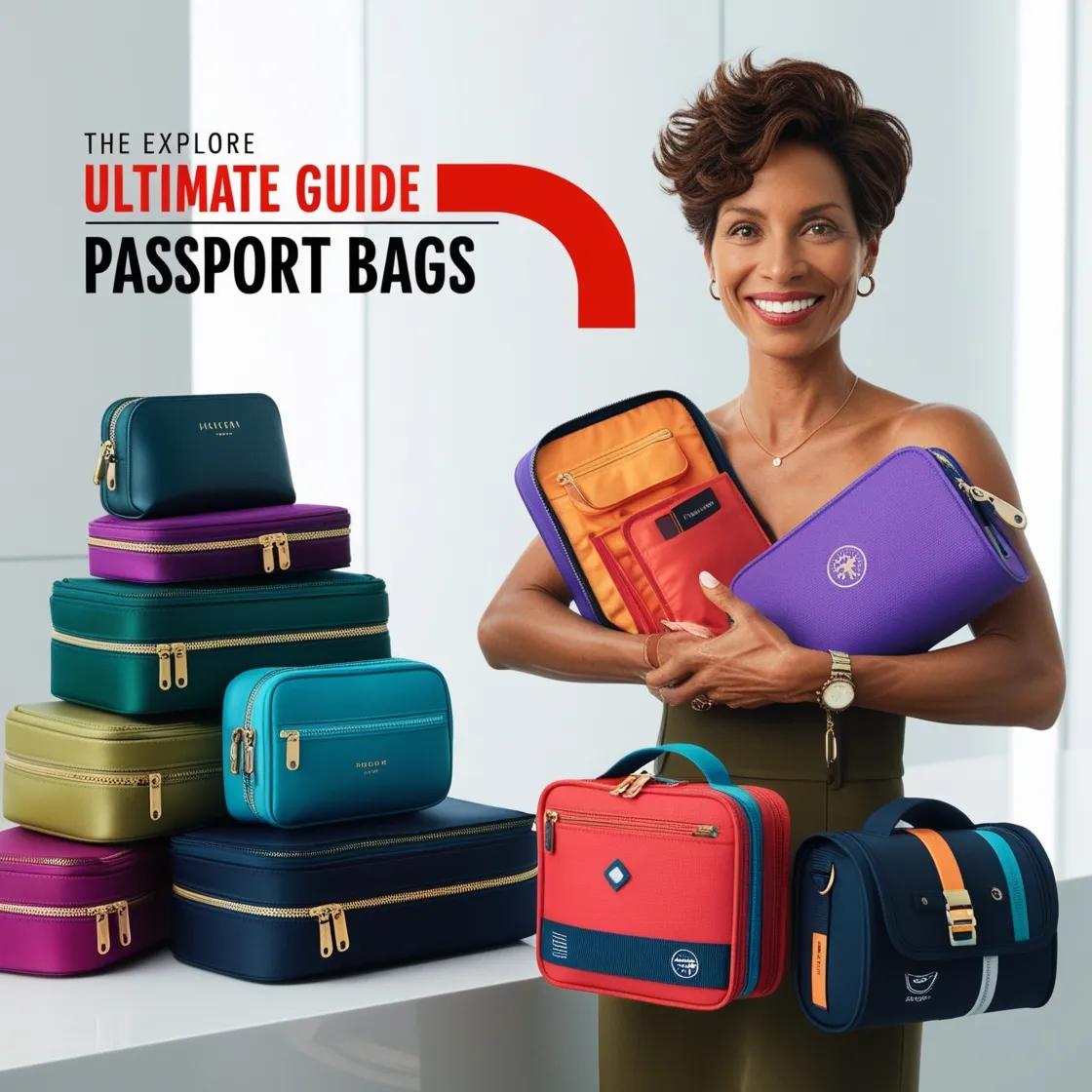

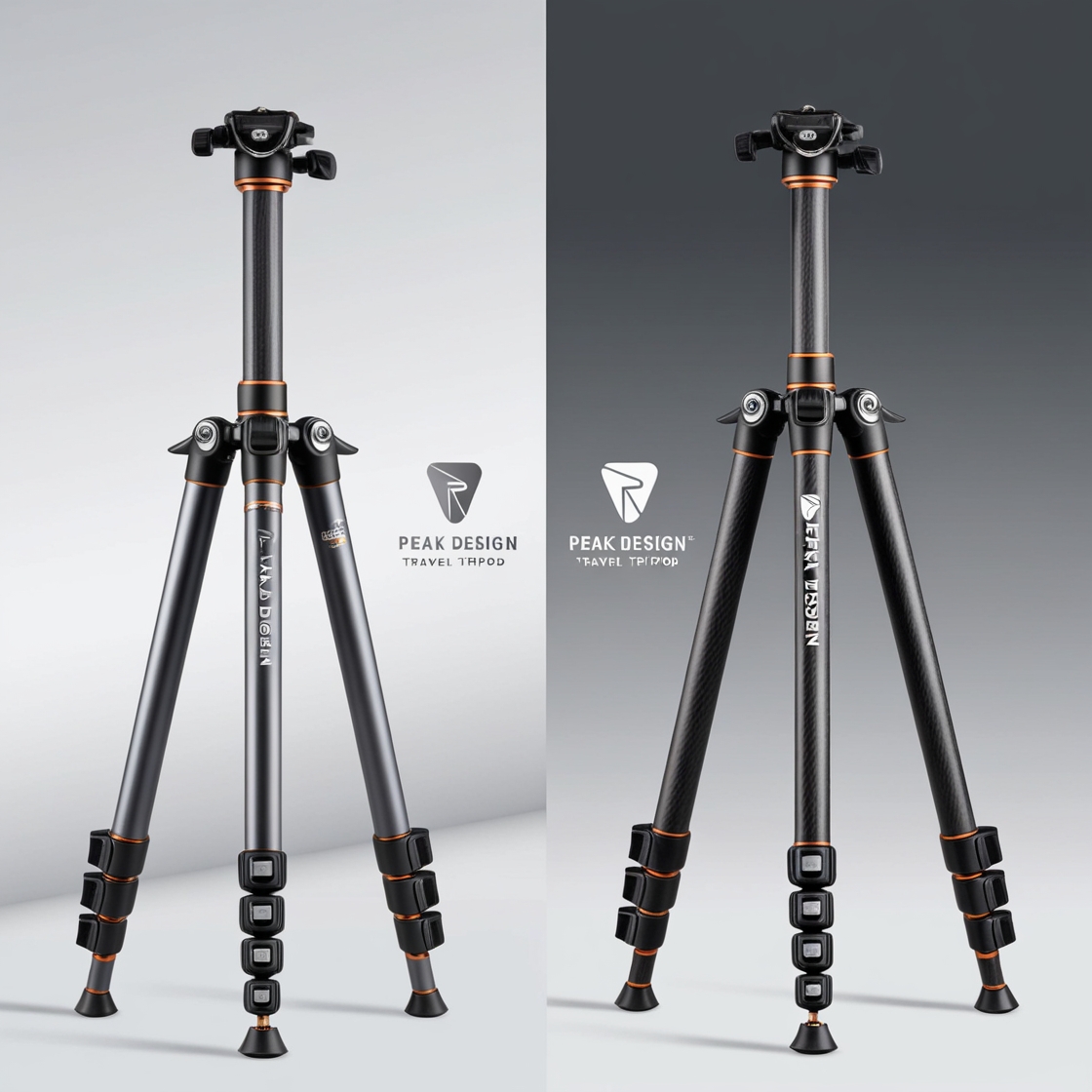











1 comment